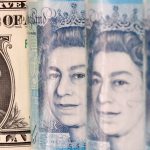LONDON (Reuters) – The dollar climbed on Thursday, while the Swiss franc dropped and the pound dipped as a busy day of central bank meetings kept currency traders alert.
The dollar index, which tracks the currency against six peers, was last up 0.28% at 105.49 after a volatile 10 days that has seen mixed signals from the U.S. economy and European markets rocked by French political uncertainty.
Helping the U.S. currency climb was a drop in the Swiss franc after the Swiss National Bank lowered interest rates to 1.25%, following on from a cut in March.
The dollar climbed 0.64% to 0.8901 francs as the Swiss currency fell from around a three-month high in the wake of the rate cut, which came with forecasts predicting a further fall in inflation to 1.1% in 2025.
“Given the appreciation of the franc in the context of the French political turbulence, we had expected a dovish message, but not a cut,” said Christian Schulz, deputy chief European economist at Citi.
“This cut could be premature if French politics stabilise and weakens the franc,” he said. The franc is seen as a safe haven and had risen over the last week.
Sterling slipped on Thursday ahead of a Bank of England (BoE) interest rate decision at 1100 GMT at which the central bank is expected to hold borrowing costs at a 16-year high of 5.25%.
The pound was down 0.14% on Thursday at $1.2701, but up from a one-month low of $1.2658 on Friday.
“The FX focus today switches to central bank meetings in Europe,” said Chris Turner, global head of markets at lender ING.
“We think that the risks of a dovish Bank of England are underpriced,” he said, using a term that typically means policymakers support interest rate cuts.
Elsewhere, the Norwegian crown rose to a four-month high against the euro after the Norges Bank held rates at a 16-year high of 4.25%.
The euro fell to its lowest since late January against the crown at 11.286, down around 0.6%.
Volatility in currency markets has picked up over the last 10 days as political uncertainty in Europe has combined with the long-standing guessing game about central bank rate cuts to cause investors new problems.
The U.S. dollar rallied last week while the euro tumbled to its lowest since May 1 as markets fretted that French President Emmanuel Macron’s gamble to call parliamentary elections could pave the way for the high-spending far right or far left to come to power.
Markets have been more placid this week. The dollar dipped after data on Tuesday showed U.S. retail sales were lower than expected in May, adding to some signs that the economy is slowing and could allow the Federal Reserve to cut interest rates in September. However, separate data showed manufacturing production surged last month.
The euro was on the back foot again on Thursday, down 0.24% at $1.0716 but still above the six-week low of $1.0667 hit on Friday.
Euro zone bond markets face a test on Thursday as France auctions debt in the midst of the political uncertainty.

Japan’s yen fell to its lowest since April 29, when Japanese authorities launched their latest round of intervention to prop it up. The dollar rose as high as 158.45 yen, up around 0.25%.
The country’s top currency diplomat Masato Kanda said there is no limit to the resources available for foreign exchange interventions, according to Jiji News Agency.
To read the full article, Click Here

